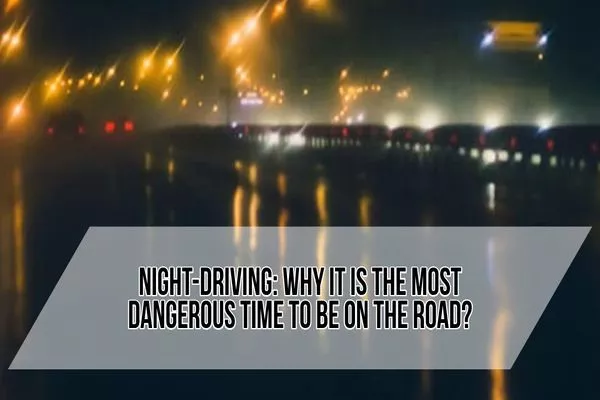What stuns us in the light winds up prudent in the night. Truly, you got it right, it is driving. With sufficient sunlight, we have all the landscape clear and brilliant in the day while driving. Comes darkness then things begin to become troublesome.
Driving during the night has its own dangers particularly when you are with an overwhelming vehicle. It is prescribed not to drive during the night whilst you are on a camping trip and remain at your outdoors spot and appreciate the night.
Night-driving has its very own problems and perils, read on this article from Philkotse.com and think about them.

Night-driving could be fun - but you should be aware of the possible perils
1. Limited visibility due to darkness
As we got accustomed to the change of sunset and sunrise during the “-ber” months, we will soon be welcoming the longer nights and shorter daylights. Meaning to say, people will spend more time driving in the dark. In spite of having full bean headlamps on, visibility on the road is restricted to around 500 ft. (250 ft. for typical headlights) giving a shorter period to counter something in the street, particularly when driving at higher paces.

The familiar saying that around evening time all felines are dark is in certainty very evident
Every one of us sees with an alternate level of perception, and around evening time that capacity is lessened, alongside the capacity to recognize protests and judge distances. Zero appears to be identical during the evening as it does amid the sunlight hours. During the evening, sizes, hues, and shapes are misshaped, and conventional items go up against a scary quality.
What to do about it?
- Back off to make up for constrained visibility and decrease speed as you drive in darkness.
- Headlights must be aimed accurately, and ensure they are spotless.
- Minimize interruptions while driving like talking on the phone or to your passenger.
- Dim the dash lights to help your eyes to adjust.
- Turn away from approaching lights of the oncoming cars.
- Make sure that your windshield is free from dirt and streaks.
2. Rigorous night-driving due to impaired vision
Age is a major component that directly affects one's ability to clearly see or perceive in the night. The older the driver, the more light he requires to see, and the more difficult it is to conform to sudden light changes such in the case of the glares from full-beam headlights.
Be that as it may, protection from glare fluctuates in all drivers. Driving at 60 miles for each hour has no difference at driving 100 miles per hour because a one-moment disability in vision on the road can mean the contrast between life and death.

This may sound sensational, yet any little change to our vision can result in disastrous outcomes out and about
What to do about it?
- Have a regular vision examination.
- For drivers who wear glasses, make sure that you wear anti-glare or anti-reflective lenses.
- Make sure that your lenses are updated and adjusted to your current eye grade.
3. Prone to fatigue due to lack of sleep
Nights are for dozing as it gives our brains the required rest after the taxing day's exercises. There are walloping numbers from around the globe of mishaps caused by restless driving during the evening. According to the reports, road accidents mostly happen at midnight to 2 a.m, 4:00 to 6:00 in the morning, and 2:00 to 4:00 in the afternoon, or during the time you would assume drivers to be exhausted.

The main thing that goes to our minds when we plan or consider night driving is rest
Drowsy driving sets everybody out and about in danger. Losing two long stretches of rest has the same impact on driving from having three bottles of beers, and tired drivers are three times more inclined to be in a road accident if they are exhausted.
What to do about it?
- Get at least seven long stretches of rest a night
- Try not to drive in the event that you've been awake for 24-hours or more
- Stop at regular intervals to rest
- Pull-over and get a quick nap in case you feel sleepy. Make sure to keep in mind these safety tips while sleeping in your car.
- Travel amid times you are typically alert
4. Impaired drivers can cause road accidents
A puppy might cross the street, the wind may have blown a block onto the road, an object may have tumbled from another vehicle, a truck without backlights may have halted dead in front of you - every one of these circumstances requires a sharp eye and brisk moving. Be that as it may, most unsafe of all our other drivers.

Besides every one of the perils with driving along with the other different drivers, your most noteworthy risk is yourself
You could experience an alcoholic driver, a driver who’s under the influence of drugs, a drained driver simply getting off the late duty, or even a decent driver who is mishandling with the radio controls. You should drive not exclusively to secure yourself, but also to guard yourself against other drivers.
Be mindful so as not to submit to the sentiment or feeling of security just from sitting contentedly behind the wheel, a long strip of road is extended before you, the engine sounding graceful, like a lullaby that puts you to sleep, and pleasure invading your contemplations and dreams.
5. Final note: Stay awake, be alert, stay alive
Sleep? No, not now! Try not to begin dreaming while you're out on the road. If you really feel the need to doze off during a long ride, simply pull-over to a safe bay and take a quick nap or simply splash some water all over your face, step out from the car and do some stretching and jog in place before heading back to driving. It is smarter to arrive late than never to arrive by any means. Another familiar saying to live by.
>>> More safety tips to drive in different conditions:
- How to drive safely in heavy rain: 5 essential tips
- Driving under stormy weather: A driver’s must-know
- How to safely drive on sand












